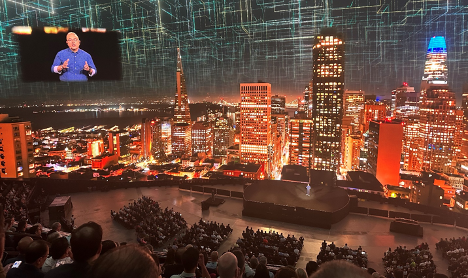
HPE Discover was held in Las Vegas the week of June 17, 2024. It was my fourth visit to Sin City over a five-week period, having previously spent time with other tech powerhouses including Cisco, Dell, Splunk and Zscaler. This year also marked the end of HPE’s standalone Aruba Atmosphere event, which I take as a signal of the importance the company assigns to integrating networking into its signature Discover show. In this research note, I will dive deeper into HPE’s networking approach as it pursues the monetization of next-generation AI applications as well as operational technology communications infrastructure.
An AI Competitive Advantage
Without exception, every technology conference that I have attended this year has focused on the sales opportunities relative to generative AI. To say the hype cycle has reached critical mass is no exaggeration, but there is merit amid the hype. GenAI is poised to disrupt nearly every industry and, in the process, deliver new levels of employee productivity, operational efficiency, and improved cybersecurity posture.
For HPE specifically, I believe that it has a unique opportunity to differentiate itself with GenAI relative to its traditional competitors Dell Technologies and Lenovo on the networking front. Much of the focus for enterprise AI continues to be on the computing infrastructure required for training and inference, and that certainly brings a tremendous top-line revenue and profit opportunity connected to modernizing data centers. However, robust networking is also required to facilitate the processing of large volumes of data, both in the cloud for working with large language models and eventually at the network edge using local processing on emerging AI PCs and other devices.
From my perspective, the combination of HPE Aruba Networking and the expected close of the Juniper Networks acquisition by the end of the year positions HPE with one of the strongest AI-infused networking portfolios. Aruba and Juniper unite routing and switching as well as wired and wireless connectivity—doing so for both enterprises and service providers. There will be portfolio overlap, but after that is rationalized we will see a powerful combination, one that will take advantage of Juniper’s Mist acquisition and its AI depth that has been refined over the past decade. I believe that long term, networking could serve as HPE’s GenAI competitive advantage.
End-to-End Private 5G Networking Made Simple
In early June, just weeks before HPE Discover 2024, the company announced its Aruba Networking Enterprise Private 5G offering. One could argue that HPE is a late entrant to the category, but as the adage goes, sometimes good things come to those who wait. To that end, there is a lot of good that comes with HPE’s private 5G cellular networking offering in the form of two advantages, especially in non-carpeted areas of the enterprise.
First and foremost, it’s an end-to-end solution that includes both HPE Athonet core and radio access network infrastructure that marries nicely to HPE ProLiant Gen11 servers. This provides customers with a fully integrated solution that includes the entire software stack—one that does not rely on a “pick your flavor” control plane or radios from the likes of Baicells, JMA Wireless, NEC, and others that often require extensive and complicated tuning and configuration. Second, HPE has a long history of providing carrier-grade orchestration, automation, provisioning, and Open RAN acceleration solutions for public mobile networks. However, HPE recently suspended its efforts tied to public telco deployments, which makes it highly likely that the company will seek to use its carrier-grade networking abilities as a leverage point for the new private 5G offering.
HPE Aruba Networking is also addressing the complexity associated with cellular networking, offering provisioning and configuration wizards that simplify deployment and ongoing management of its private 5G offering. HPE claims that its solution can be deployed in under 30 minutes, and if that’s the case it’s a potential game changer. Indeed, it could extend HPE’s connectivity reach across every business operational area, including use cases tied to manufacturing automation, logistics and warehousing, IoT, and more.
Hewlett Packard Labs as a GenAI Accelerant
HPE Discover 2024 went far to demonstrate the company’s opportunities to capitalize on its strengths in networking and address the extensive requirements of both GenAI applications and cellular connectivity for operational technology environments in the enterprise.
After meeting with executives at the event and learning more about Hewlett Packard Labs, I also believe that Labs could accelerate the company’s GenAI efforts. The Labs organization is engaged in applied research in both GenAI and data center sustainability. The power consumption of the GPUs and NPUs used for AI workloads is massive, and if HPE’s research efforts are effective in reducing it, the company could be well positioned to capture more share through sustainability gains and broader GenAI use cases.























































































